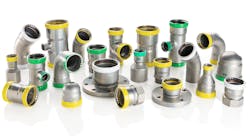My friend Gary Klein, Affiliated International Management, has been crusading about saving hot water for a long time, starting with home use. There are a lot of dumb home plumbing systems out there, the kind where the homeowner turns on the shower and then leaves to make a pot of coffee in the hopes that there will be hot water in the shower by the time he returns. One of the worst installations Klein has seen was one where the hot water supply piping from the water heater in the garage didn't run directly to the fixtures — it went straight up to the attic and then over and down again.
The best way to supply hot water in a house is with a recirculating hot water system with insulated pipes and a pump that’s activated on demand with a push button or motion sensor.
Now it's time to look at saving hot water in commercial buildings. Some of them are pretty good. I attended the Uponor Convention last spring at the Bellagio Hotel in Las Vegas and I was impressed to find hot water flowing immediately from the taps at every faucet I used in the hotel. The engineer and the mechanical contractor knew what they were doing on that job. I wondered aloud if they had heat-traced the hot water lines at the Bellagio and Gary said he would poke around to see if he could find out.
Other buildings are very bad. At another water and energy conservation session held in an Ontario, Calif., hotel, there was not hot water in the men's rooms. As Klein noted at the time, we could stand in front of those sinks for a half hour and never get hot water.
Fortunately, both the International Code Council's International Green Construction Code committee and the Green Technical Committee of the International Association of Plumbing & Mechanical Officials have turned their attention to hot water use in commercial buildings.
The IGCC committee accepted Klein’s suggestion that, "The volume of water in the piping between the source of hot water and the hot water outlets of shower, sink and lavatory fixture fittings shall not exceed 80 ounces (2.35 L). The volume of water contained in fixture branch piping that connects to a hot water circulation loop or electrically heat-traced pipe shall not exceed 24 ounces (0.70 L)." The IAPMO GTC wants no more than 16 ounces in the run-out from the hot water source to the fixture stop.
You may be wondering how you can reduce the amount of water in branch lines that low, but there's really not a lot of water there. Here's the arithmetic.
The codes both talk about the "source" of hot water. The source would be an insulated recirculating line — not the water heater or boiler. That means we're talking about the run-outs from the recirc line to the fixture stop for the faucet. Eight ounces of water, which is one cup, occupy approximately 5-ft. of ½-in. copper pipe and about 6.6-ft. of ½-in. PEX.
IAPMO's Green Technical Committee calls for roughly 2-cups from the run-outs. The IGCC calls for a little more, 24-ounces, from the loop to the shutoff valve. The IGCC rationale for this is for flexibility for tall first floors in some commercial buildings, which is not unusual since architects like to design grand entrances into their buildings.
The bigger problem that arises from all of this is what to do with the mandated 0.5-gpm lavatory faucets that really use a mere ¼-gpm on the hot side. That's a quart, 4-cups. If there are 2-cups sitting in the run-out that you have to clear that out, it will take 30 seconds before the hot water arrives. The American Society of Plumbing Engineers says that 10 seconds is acceptable and we're not even close. It may be time to tweak the codes to allow smaller tube, 3/8-inch or even ¼-in. It's either that or we'll need to change the allowable flow rate for lav faucets.
For now, however, what's being put in the green codes is buildable. It takes some thinking and planning, but it can be done. Thirteen feet of PEX from the loop in the ceiling down to the shutoff valve is doable.

